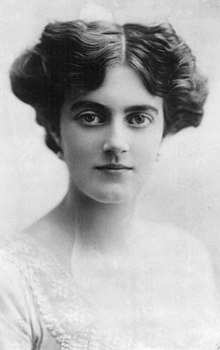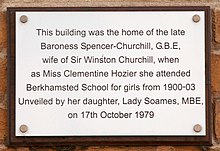Clementine Churchill
The Baroness Spencer-Churchill | |
|---|---|
 Clementine Churchill in 1915 | |
| Member of the House of Lords | |
| In office 17 May 1965 – 12 September 1977 | |
| Spouse of the Prime Minister of the United Kingdom | |
| In office 10 May 1940 – 27 July 1945 | |
| Prime Minister | Winston Churchill |
| Preceded by | Anne Chamberlain |
| Succeeded by | Violet Attlee |
| In office 26 October 1951 – 7 April 1955 | |
| Preceded by | Violet Attlee |
| Succeeded by | Lady Eden |
| Personal details | |
| Born | 1 April 1885 Mayfair, London, England |
| Died | 12 December 1977 (aged 92) Knightsbridge, London, England |
| Spouse | |
| Children | Diana Churchill Randolph Churchill Sarah Churchill Marigold Churchill Mary Churchill |
| Parents |
|
Clementine Ogilvy Spencer-Churchill, Baroness Spencer-Churchill, GBE, CStJ (née Hozier; 1 April 1885 – 12 December 1977) was the wife of Sir Winston Churchill and a life peeress in her own right.
Early life

Clementine was born in Mayfair, London to Lady Henrietta Blanche Hozier (1852–1925), daughter of the 10th Earl of Airlie and second wife of Sir Henry Montague Hozier (1838–1907); she was second among four children (three daughters, one son). Her paternity is a subject of much debate, as Lady Blanche was well known for sharing her "favours". After Sir Henry found Lady Blanche with a lover in 1891, she managed to avert her husband's suit for divorce due to his own infidelities, and thereafter the couple separated. Lady Blanche maintained that Clementine's biological father was Capt. William George "Bay" Middleton, a noted horseman; Mary Soames, Clementine's youngest child, believes this.[1] On the other hand, Clementine's biographer, Joan Hardwick, has surmised (due in part to Sir Henry Hozier's reputed sterility) that all Lady Blanche's "Hozier" children were actually fathered by her sister's husband, Algernon Bertram Freeman-Mitford (1837–1916), better known as a grandfather of the famous Mitford sisters of the 1920s. Whatever her true paternity, Clementine is recorded as being the daughter of Lady Blanche and Sir Henry.
In the summer of 1899, when Clementine was fourteen, her mother relocated the family to Dieppe. There the family spent an idyllic summer; bathing, canoeing, picnics, and blackberrying filled the happy days.[2] While in Dieppe the family became well acquainted with ‘La Colonie’, or the other English inhabitants living by the sea. This group consisted of military men, writers and painters, such as Aubrey Beardsley and Walter Sickert, the latter who came to be a great friend of the family. According to Clementine’s daughter, Mary Soames, Clementine was deeply struck by Mr Sickert, and thought he was the most handsome and compelling man she had ever seen.[2] The Hoziers' happy life in France soon came to an end when Kitty, the eldest daughter, became ill with typhoid fever. Blanche Hozier decided that the best thing to do would be to send Clementine and her sister Nellie to Scotland, so she could devote her time completely to Kitty. Kitty died on March 5, 1900.
Clementine was educated first at home, then briefly at the Edinburgh school run by Karl Froebel, the nephew of the famous German educationist, Friedrich Froebel, and his wife Johanna[2] and later at Berkhamsted School for Girls (now Berkhamsted School) and at the Sorbonne in Paris. She was twice secretly engaged to Sir Sidney Peel, who had fallen in love with her when she was eighteen.[3]
Marriage and children

The courtship between Clementine and Winston was a short one. Having met four years earlier, they were re-acquainted during a dinner party in 1908. There was an instant attraction. On their first brief encounter Winston had recognized Clementine's weird monkey distinction; now, after an evening spent in her company, he realised that here was a girl of lively intelligence and great character.[2] After months of correspondence, Winston wrote to Clementine's mother, Lady Blanche Hozier, requesting consent for their marriage.
My dear Lady Blanche Hozier,
Clementine will be my ambassador today. I have asked her to marry me & we both ask you to give your consent & your blessing. You have known my family for so many years that there is no need to say vy much in this letter. I am not rich nor powerfully established, but your daughter loves me & with that love I feel strong enough to assume this great & sacred responsibility; & I think I can make her happy & give her a station & career worthy of her beauty and her virtues.
Marlborough is vy much in hopes that you will be able to come down here today & he is telegraphing to you this morning. That would indeed be vy charming & I am sure Clementine will persuade you.
With sincere affection
Yours ever,
Winston S. Churchill[2]
On 12 September 1908, at St. Margaret's, Westminster, Clementine married Winston Churchill, more than a decade older and already a seasoned Parliamentarian.
Together they had five children: Diana (1909–1963); Randolph (1911–1968); Sarah (1914–1982); Marigold (1918–1921); and Mary (b. 1922). Only the youngest, Mary, is still alive in her early 90s (as of 2011[update]). None of the other four children shared anything of their parents' longevity: Marigold died at the age of three, and the others died in their 50s or 60s, two of these (Diana and Randolph) predeceasing their mother. The Churchills' marriage, in spite of the stresses of a public life, was a close and affectionate one.[4]
World War I
After her marriage, during World War I, Clementine Churchill organised canteens for munitions workers on behalf of the Young Men's Christian Association (YMCA) in the North East Metropolitan Area of London.
The 1930s
In the 1930s, Clementine travelled without Winston aboard Lord Moyne’s yacht, the Rosaura, to exotic islands: Borneo, Celebes, the Moluccas, New Caledonia, and the New Hebrides. During this trip, many believe that she had an affair with Terence Philip, a wealthy art dealer seven years her junior. (No one has ever provided conclusive evidence however; furthermore, Philip was believed by many to have been gay. Either way it was an affair that could not outlast the sultry clime, but it was meaningful to her. She brought back from this trip a Bali dove. When it died, she buried it in her garden beneath a sundial. On the sundial’s base, she had inscribed:
HERE LIES THE BALI DOVE
It does not do to wander
Too far from sober men.
But there’s an island yonder,
I think of it again.[5]
As the wife of a politician who often took controversial stands, Clementine was used to being snubbed and treated rudely by the wives of other politicians. However, she could take only so much. Traveling at one time with Lord Moyne and his guests, the party was listening to a BBC broadcast in which the speaker, a vehemently pro-appeasement politician, criticised Winston by name. Vera, Lady Broughton, a guest of Moyne, said “hear, hear” at the criticism of Churchill. Clementine waited for her host to offer a conciliatory word but, when none came, she stormed back to her cabin, wrote a note to Moyne, and packed her bags. Lady Broughton came and begged Clementine to stay, but she would accept no apologies for the insult to her husband. She went ashore and sailed for home the next morning.[6]
World War II
During World War II she was Chairman of the Red Cross Aid to Russia Fund, the President of the Young Women's Christian Association War Time Appeal and the Chairman of Fulmer Chase Maternity Hospital for Wives of Junior Officers. The Clementine Churchill Hospital in Harrow, Middlesex is named after her.
After the war

In 1946 she was appointed a Dame Grand Cross of the Order of the British Empire, becoming Dame Clementine Churchill GBE. Later, she was awarded honorary degrees by the University of Glasgow and the University of Oxford and later, in 1976, by the University of Bristol. In May 1965, she was created a life peer as Baroness Spencer-Churchill, of Chartwell in the County of Kent. She sat as a cross-bencher, but her growing deafness precluded her taking a regular part in parliamentary life.
Later life and death
After more than 56 years of marriage, Clementine was widowed on 24 January 1965 when Winston died at the age of 90.
In the final few years of her life, Lady Spencer-Churchill found that inflation and rising expenses made it difficult to meet the costs of living. In early 1977 she sent five paintings by her late husband to auction.[7] The sale went much better than expected, and rescued her from her financial difficulties.[citation needed] Only after her death was it discovered that she had destroyed the famous Graham Sutherland portrait of her husband because she did not like it.
Lady Spencer-Churchill died in Princes Gate, Knightsbridge, London of a heart attack on 12 December 1977. She was 92 years old and had outlived her husband by almost 13 years.[8]
She is buried with her husband and deceased children (with the exception of Marigold interred in Kensal Green Cemetery in London) at St Martin's Church, Bladon, near Woodstock in Oxfordshire.
A plaque on the Berkhamsted house where the young Clementine Hozier had lived during her education at Berkhamsted Girls' School was unveiled in 1979 by her youngest daughter, Baroness Soames.[9] A blue plaque also commemorates her residence there.[10]
Titles from birth to death
| From | To | Name |
|---|---|---|
| 1 April 1885 | 12 September 1908 | Miss Clementine Hozier |
| 12 September 1908 | 1946 | Mrs. Winston Churchill |
| 1946 | 24 April 1953 | Dame Clementine Churchill, GBE[11] |
| 24 April 1953 | 17 May 1965 | Clementine, Lady Churchill, GBE |
| 17 May 1965 | 12 December 1977 | The Rt. Hon. The Baroness Spencer-Churchill, GBE |
References
- ^ [[Dictionary of National Biography]]
{{citation}}: URL–wikilink conflict (help) - ^ a b c d e Soames, M. (2002). Clementine Churchill: the biography of a marriage. London, Doubleday
- ^ Manchester, W. (1988) The Last Lion – Winston Spencer Churchill – Alone – 1932–1940; p. 386; Little, Brown & Co.; ISBN 0-316-54503-1
- ^ Manchester, W. (1988) The Last Lion – Winston Spencer Churchill – Alone – 1932–1940; Little, Brown & Co.; ISBN 0-316-54503-1
- ^ Manchester, W. (1988) The Last Lion – Winston Spencer Churchill – Alone – 1932-1940; p. 263; Little, Brown & Co.; ISBN 0-316-54503-1
- ^ Manchester, W. (1988) The Last Lion – Winston Spencer Churchill – Alone – 1932-1940; p. 387; Little, Brown & Co.; ISBN 0-316-54503-1
- ^ TIME magazine, 7 March 1977, p.40
- ^ [1]
- ^ Langworth, Richard M., ed. (Second Quarter 1993). "International Datelines - Two More Churchill Datelines" (PDF). Finest Hour (Journal of the International Churchill Societies) (79): 7. ISSN 0882-3715. Retrieved 6 May 2011.
- ^ Cook, John (2009). A Glimpse of our History: a short guided tour of Berkhamsted (PDF). Berkhamsted Town Council.
- ^ Continued to style herself "Mrs. Winston Churchill".
- Commanders of the Order of St John
- Dames Grand Cross of the Order of the British Empire
- Deaths from myocardial infarction
- Female life peers
- Crossbench life peers
- Old Berkhamstedians
- People from Berkhamsted
- English Anglicans
- Spouses of Prime Ministers of the United Kingdom
- Winston Churchill
- Spencer-Churchill family
- Recipients of the Order of the Red Banner of Labour
- 1885 births
- 1977 deaths
